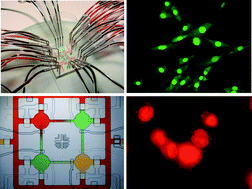An integrated microfluidic system for studying cell-microenvironmental interactions versatilely and dynamically†
Abstract
We presented an integrated microfluidic system for dynamical study of

* Corresponding authors
a
College of Animal Medicine, Northwest A&F University, Yangling, Shaanxi, China
E-mail:
jywang@nwsuaf.edu.cn
Fax: +86-298-708-2520
Tel: +86-298-708-2520
b College of Life Science, Northwest A&F University, Yangling, Shaanxi, China
c College of Science, Northwest A&F University, Yangling, Shaanxi, China
d Shaanxi Key Laboratory of Molecular Biology for Agriculture, Yangling, Shaanxi, China
We presented an integrated microfluidic system for dynamical study of

 Please wait while we load your content...
Something went wrong. Try again?
Please wait while we load your content...
Something went wrong. Try again?
W. Liu, L. Li, X. Wang, L. Ren, X. Wang, J. Wang, Q. Tu, X. Huang and J. Wang, Lab Chip, 2010, 10, 1717 DOI: 10.1039/C001049A
To request permission to reproduce material from this article, please go to the Copyright Clearance Center request page.
If you are an author contributing to an RSC publication, you do not need to request permission provided correct acknowledgement is given.
If you are the author of this article, you do not need to request permission to reproduce figures and diagrams provided correct acknowledgement is given. If you want to reproduce the whole article in a third-party publication (excluding your thesis/dissertation for which permission is not required) please go to the Copyright Clearance Center request page.
Read more about how to correctly acknowledge RSC content.
 Fetching data from CrossRef.
Fetching data from CrossRef.
This may take some time to load.
Loading related content
